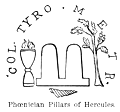Columnae Hercŭlis
“The Pillars of Hercules”; a name often given to Calpé and
Abyla, or the heights on either side of the Straits of Gibraltar. The tradition was that the
Mediterranean had no outlet in this quarter until Hercules broke through the mountain barrier,
and thus formed the present straits. The rocky height on either side of the opening was fabled
to have been placed there by him as a memorial of his achievement, and as marking the limits
of his wanderings towards the west. See
Abyla;
Calpé;
Mediterraneum Mare.
The name Columnae Herculis was also often applied to the two large pyramidal columns set up
by the Phœnicians in their voyages as landmarks
 |
|
Column of Theodosius II.
|
by which to recognize particular coasts on subsequent visits. These pillars
were respectively
 |
|
Phœnician Pillars of Hercules.
|
dedicated to the Phœnician Hercules and to Astarté, as
personifying the sun and the moon. (See Tac.
Germ. 34.) The accompanying illustration is taken from a Tyrian coin.






